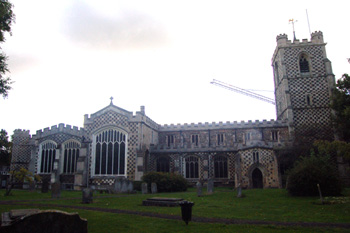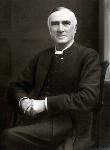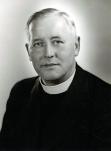List of Luton Vicars
![The font at Saint Mary's [Z50/75/27]](/CommunityHistories/Luton/LutonImages/The font at Saint Marys [Z50-75-27].jpg)
The font at Saint Mary's [Z50/75/27]
Advowson
The Domesday Book of 1086 noted that Luton church was held by William, the King's chamberlain, having been held by one Morcar, the priest, during the reign of Edward the Confessor (1042 to 1066). A William the Chamberlain, perhaps son or grandson of the Domesday William, held the church from Earl Robert of Gloucester during the early part of the reign of King Stephen (1135 to 1154). Earl Robert transferred the advowson of Luton, Saint Mary to Saint Albans Abbey later in Stephen's reign and the abbey held it until the Dissolution when it passed to the Crown. The abbey acted as rector and, in the early 13th century, appointed a man to act vicariously on its behalf in the parish - the vicar.
In 1623 Sir Robert Napier, Lord of the Manor of Luton, was granted the advowson. The advowson then remained part of the Manor of Luton until 1845 when it was sold to Thomas Sykes, who became Vicar in 1850. He sold it to Thomas Williamson Peile, a successor as vicar, in 1857 and he to a later vicar, James O'Neill in 1862. On his death the advowson was purchased by the Peache Trustees, who still own it at the time of writing [2009].

Saint Mary's from the north September 2009
Vicars
The first mention of a vicarage in Luton (that is the office of vicar, not the vicarage house) is in 1209 [P85/2/2/1] when it was endowed by the rector which, as noted above, was Saint Albans Abbey. Sadly a name is not associated with this endowment. The first known Vicar is Simon of Luton in 1215. A list of Vicars of Saint Mary, as far as can be reconstructed, is as follows:
- 1215: Simon of Luhton, clerk;
- 1220: John Phisicus;
- 1227: Adam de Belescot , chaplain;
- 1248: Henry; chaplain, late Vicar of Kenebell, vacancy by the entry of Adam, the last Vicar, into an order of Friars Preachers;
- 1249: Geoffrey;
- 14th February 1275: Roger de Marsle; priest, on the death of Geoffrey;
- 29th September 1279: Hugh de Banebur'; chaplain, on the death of Roger;
- 15th December 1316: John de Wilden, priest, on the resignation of Hugh de Barneborough;
- Roger de Salesbury;
- 13th March 1331: John de Stanfordham, priest, on the resignation of Roger de Salesbury who exchanged to Eversholt Rectory;
- 17th June 1346: John Raser de Luyton, Rector of Weryngton in the Diocese of Coventry, by exchange with John de Stanfordham;
- 7th April 1349: Andrew Power; priest, of Mentmore [Buckinghamshire], on the death of John [of Black Death?];
- 28th June 1349: Richard de Rothele [on the death of Andrew Power in the Black Death?];
- 24th February 1350: William de la Chaumbre, deacon, of St Neots [Huntingdonshire], on the resignation of Richard de Rothele;
- 4th August 1353: John Lyberd, priest, of Strixton [Northamptonshire];
- 27th September 1366: Benedict de Mattingham;
- 1369: Robert de Wyssyncest;
- Walter Ixworth;
- 3rd March 1393: John Pecke, priest, on the resignation of Walter Ixworth;
- John Bloneham;
- John Penthlyn;
- 1st March 1444: Rogerus Burgh, on the death of John Pynthlyn;
- 22nd July 1454: John Lammer, on the resignation of Roger Burgh;
- 12th October 1477: Richard Bernard, on the death of John Ladmer;
- 5th November 1492: Adrianus Castellen, on the death of Richard Bernard;
- 9th May 1502: Edward Sheffeld, priest, on the consecration of Adrian Castellen as Bishop of Hereford;
- 31st March 1526: Richard Doke, on the death of Edward Sheffeld;
- 1526: Thomas Heritage - 1526
- 23rd December 1537: John Gwynneth, clerk, on the death of Thomas Heritage;
- 1st December 1558: George Mason, priest, on the death of John Gwynneth;
- 10th March 1562: Thomas Rose, clerk, on the death of the last vicar;
- 6th July 1574: William Horne, A.M., presented on the resignation of Thomas Rose;
- 22nd March 1593: Edmond Brockett [M.A., vicar;
- 2nd October 1617: John Birde;
- 3rd March 1645: Thomas Atwood Rotherham, intruded;
- 1650: Thomas Jessop, intruded;
- 20th December 1660: Thomas Pomfret, clerk;
- 24th May 1706: Christopher Eaton A.M., on the death of Thomas Pomfret;
- 19th December 1745: George Barnard B.A., on the death of Eaton;
- 14th November 1760: William Prior, clerk, on the death of George Bernard;
- 6th June 1762: Allin Walker B.A., St John's College Cambridge, ordained deacon;
- 21st July 1779: The Honourable William Stuart M.A., on death of William Prior;
- 6th February 1794: James Russell Deare, clerk, on the promotion of William Stuart to be Bishop of St David's;
- 3rd June 1798: Stuart Corbett B.A., the on resignation of J R Deare;
- 9th April 1804: Charles Henry Hall D.D., on the resignation of Stuart Corbett;
- 20th December 1827: William McDouall M.A., on the death of C H Hall;
- 3rd January 1850: Thomas Sikes M.A., on the death of William McDouall;
- 25th March 1854: Thomas Bartlett M.A., on the resignation of Thomas Sikes;
- 30th September 1857: Thomas Williamson Peile D.D., to Luton Vicarage, with East Hyde Chapel, on the resignation of Thomas Bartlett;
- 21st February 1861: George Quirk M.A., on the resignation of Thomas Williamson Peile, D.D.;
![James O'Neill [P85/28/4/25]](/CommunityHistories/Luton/LutonImages/P85-28-4-25 James ONeill_118x150.jpg)
James O'Neill [P85/28/4/25]
- 25th April 1862: James O'Neill, clerk, on the resignation of George Quirk;

Edmund Robert Mason [P85/28/4/26]
- 1897: Edmund Robert Mason M.A.;
![Charles Mollan Williams [P85/28/4/28]](/CommunityHistories/Luton/LutonImages/P85-28-4-28 C Mollan Williams_116x150.jpg)
Charles Mollan Williams [P85/28/4/28]
- December 1921: Charles Mollan Williams;

William Davison [P85/28/4/31]
- July 1933: William Davison;
- 1961: Harold Edward Frankham;
- 1971: Christopher John Mayfield;
- 1980: David John Banfield;
- 1991: Nicholas Philip Johnson Bell.
![The Wenlock Chapel in 1805 [X254/88/171]](/CommunityHistories/Luton/LutonImages/The Wenlock Chapel in 1805 X254-88-171.jpg)
The Wenlock Chapel in 1805 [X254/88/171]
Episcopal Visitations
Volume 81 published by the Bedfordshire Historical Records Society (2002) is devoted to returns made during episcopal visitations to the county by the Bishop of Lincoln in the early 18th century, edited by former County Archivist Patricia Bell. It throws some interesting light on the general state of the church in the parish.
In 1706 the Vicar, Christopher Eaton, said of the parish: "It extends in length about 7 miles, in breadth 5, in compass 21. The number of families great, the Town and Parish being very populous. The Dissenters are many, and of all sorts: Presbyterians, Quakers, but especially Anabaptists, of which there are 2 sorts, and each has its Meeting house". When speaking of his patron, the vicar said: "The only family of note now residing within the parish is that of Sir John Napier, of Luton-Hoe [sic], who has a very neat chappell [sic] in his House, consecrated, and kept very decently". Of the church he said: "There is nothing remarkable in the parish Church except it be Sumeres [Someries] Chappell, founded by John, Lord Wenlock, since maintained by the family of the Rotherhams, planted here by Thomas Rotherham, Archbishop of York and Chancellor of England. Since that sold by the Crawleys, and with the estate belonging to Sir John Napier. There are in this chappell severall [sic] antient [sic] Monuments, much defaced, and the Inscriptions scarce legible".
In 1709 Eaton recorded that 120 had received communion at Easter last, out of an estimated population in the parish of four thousand. In 1712 he reckoned that about 12.5% of the parish were dissenters (50 out of 400 families) "chiefly Anabaptists". He stated "The Vicar resides in his Vicarege [sic] House". He delivered two services on a Sunday and now about 140 people received communion. In 1717 he stated: "I reside personally on my Cure, and doe [sic] all offices my selfe [sic] but doe not actually live in my Vicarage House, having obtained the favour of His Grace of Canterbury to live in one that is more Convenient for me, and I Annually beseech your Lordship to grant me the liberty, the vicarage house being well repaired at my cost and now well tenanted". The position remained unchanged in 1720.
![Luton Vicarage about 1900 [Z580/10]](/CommunityHistories/Luton/LutonImages/Luton Vicarage about 1900 Z580-10.jpg)
Luton Vicarage about 1900 [Z580/10]
1851 Ecclesiastical Census
On Sunday 30th March 1851 a census of all churches, chapels and preaching-houses of every denomination was undertaken in England and Wales. The local results were published by Bedfordshire Historical Records Society in 1975 as Volume 54, edited by D. W. Bushby. The return for Luton, Saint Mary noted that the parish contained 12,787 and included Hyde, Stopsley, Limbury and Leagrave. Saint Mary's had 560 free seats and 700 leased along with forms for 150 "in Aisles & Boys' Gallery" - a total, when full, of just over 1,500. The general congregations on 30th March were: 550 adults and 400 children in the morning, 450 adults and 422 children in the afternoon and 1,200 adults and 130 children in the evening, making this the best attended service of the day. The averages were 600 adults and 400 children in the mornings and 800 adults and 450 children in the afternoon. The vicar noted: "Evening service was only commenced last August, and the average congregation has been between 13 & 1400. No attempt was made to increase it on the 30th".